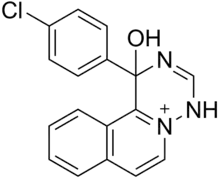Trazium
Trazium (EGYT-3,615) is an antidepressant drug which was never marketed.[1] It has psychostimulant-like effects and its actions appear to be mediated by the dopaminergic and adrenergic systems.[2] It was formulated as a salt with ethanesulfonic acid and given the generic name trazium esilate (INN).[3]
This article is about an antidepressant. For the antibiotic with the trade name Trazium, see ceftriaxone.
 | |
| Clinical data | |
|---|---|
| Routes of administration | Oral |
| ATC code |
|
| Legal status | |
| Legal status |
|
| Identifiers | |
IUPAC name
| |
| CAS Number | |
| PubChem CID | |
| ChemSpider | |
| UNII | |
| CompTox Dashboard (EPA) | |
| Chemical and physical data | |
| Formula | C17H13ClN3O |
| Molar mass | 310.76 g·mol−1 |
References
- David J. Triggle (1996). Dictionary of Pharmacological Agents. Boca Raton: Chapman & Hall/CRC. ISBN 0-412-46630-9.
- Gyertyán I, Petöcz L, Bajnógel J, et al. (July 1989). "Possible involvement of the dopaminergic system in the mode of action of the potential antidepressant trazium esilate". Arzneimittel-Forschung. 39 (7): 775–81. PMID 2551306.
- "Trazium Esilate". ChemSpider.
Adrenergic receptor modulators | |||||
|---|---|---|---|---|---|
| α1 |
| ||||
| α2 |
| ||||
| β |
| ||||
| |||||
| D1-like |
| ||||||
|---|---|---|---|---|---|---|---|
| D2-like |
| ||||||
| |||||||
This article is issued from Wikipedia. The text is licensed under Creative Commons - Attribution - Sharealike. Additional terms may apply for the media files.